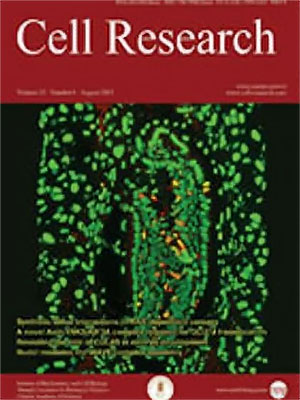
Volume 15, No 8, Aug 2005
ISSN: 1001-0602
EISSN: 1748-7838 2018
impact factor 17.848*
(Clarivate Analytics, 2019)
Volume 15 Issue 8, August 2005: 567-575
ORIGINAL ARTICLES
Identification and characterization of GIP1, an Arabidopsis thaliana protein that enhances the DNA binding affinity and reduces the oligomeric state of G-box binding factors
Paul C. Sehnke1, Beth J.Laughner1, Carla R. Lyerly Linebarger1, William B.Gurley2, Robert J. Ferl1,*
1Program in Plant Cellular and Molecular Biology, Department of Horticultural Sciences, University of Florida, Gainesville,
FL 32611, USA
2Department of Microbiology and Cell Science, University of Florida, Gainesville, FL 32611, USA
Correspondence: Robert J Ferl(robferl@ufl.edu)
Environmental control of the alcohol dehydrogenase (Adh) and other stress response genes in plants is in part brought about by transcriptional regulation involving the G-box cis-acting DNA element and bZIP G-box Binding Factors (GBFs). The mechanisms of GBF regulation and requirements for additional factors in this control process are not well understood. In an effort to identify potential GBF binding and control partners, maize GBF1 was used as bait in a yeast two-hybrid screen of an A. thaliana cDNA library. GBF Interacting Protein 1 (GIP1) arose from the screen as a 496 amino acid protein with a predicted molecular weight of 53,748 kDa that strongly interacts with GBFs. Northern analysis of A. thaliana tissue suggests a 1.8-1.9 kb GIP1 transcript, predominantly in roots. Immunolocalization studies indicate that GIP1 protein is mainly localized to the nucleus. In vitro electrophoretic mobility shift assays using an Adh G-box DNA probe and recombinant A. thaliana GBF3 or maize GBF1, showed that the presence of GIP1 resulted in a tenfold increase in GBF DNA binding activity without altering the migration, suggesting a transient association between GIP1 and GBF. Addition of GIP1 to intentionally aggregated GBF converted GBF to lower molecular weight macromolecular complexes and GIP1 also refolded denatured rhodanese in the absence of ATP. These data suggest GIP1 functions to enhance GBF DNA binding activity by acting as a potent nuclear chaperone or crowbar, and potentially regulates the multimeric state of GBFs, thereby contributing to bZIP-mediated gene regulation.
FULL TEXT | PDF
Browse 2150


